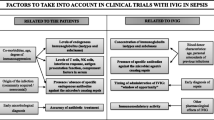Abstract
The role of glucocorticosteroids in the management of infectious diseases in man remains controversial, although experimental data obtained both in in vitro systems and in experimental infections in animals provide evidence of a beneficial effect of such treatment. Their use in the treatment ofPneumocystic carinii pneumoniae and severe typhoid fever seems indicated. A beneficial effect on the treatment of bacterial meningitis needs to be confirmed. Sufficient data are now available that argue against steroid treatment in septic shock. However, new treatment modalities such as monoclonal antibodies against endotoxin and inflammatory mediators are currently being developed to modulate infectious inflammation. This could also bring a renaissance of the role of glucocorticosteroids in the treatment of infectious diseases.
Similar content being viewed by others
References
Hench PS, Kendall EC, Slocumb CH, Polley HF: The effect of a hormone of the adrenal cortex (17-hydroxy-11-dehydrocorticosterone: compound E) and of pituitary adrenocorticotropic hormone on rheumatoid arthritis. Proceedings of the Staff Meetings of the Mayo Clinics 1949, 24: 181–197.
Weitzman S, Berger S: Clinical trial design in studies of corticosteroids for bacterial infections. Annals of Internal Medicine 1974, 81: 36–42.
Young LS, Proctor RA, Beutler B, McCabe WR, Sheagren JN: University of California/Davis interdepartmental conference on gram-negative septicemia. Reviews of Infectious Diseases 1991, 13: 666–687.
Cline MJ, Melmon KL: Plasma kinins and cortisol: a possible explanation of the anti-inflammatory action of cortisol. Science 1966, 153: 1135–1137.
Lew, W, Oppenheim JJ, Matsushima K: Analysis of the suppression of IL-1α and IL-1β production in human peripheral blood mononuclear adherent cells by a glucocorticoid hormone. Journal of Immunology 1988, 140: 1895–1902.
Dinarello CA: The proinflammatory cytokines interleukin-1 and tumor necrosis factor and treatment of the septic shock syndrome. Journal of Infectious Diseases 1991, 163: 1177–1184.
Mustafa MM, Ramilo O, Mertsola J, Risser RC, Beutler B, Hansen EJ, McCracken GH: Modulation of inflammation and cachectin activity in relation to treatment of experimentalHemophilus influenzae type b meningitis. Journal of Infectious Diseases 1989, 160: 818–825.
McGowan JE, Chesney PJ, Crossley KB, LaForce FM: Guidelines for the use of systemic glucocorticosteroids in the management of selected infections. Journal of Infectious Diseases 1992, 165: 1–13.
The National Institutes of Health-University of California Expert Panel for Corticosteroids as Adjunctive Therapy for Pneumocystis Pneumonia: Consensus statement on the use of corticosteroids as adjunctive therapy forPneumocystis pneumonia in the acquired immunodeficiency syndrome. New England Journal of Medicine 1990, 323: 1500–1504.
Tuomanen E, Tomasz A, Hengstler B, Zak O: The relative role of bacterial cell wall and capsule in the induction of inflammation in pneumococcal meningitis. Journal of Infectious Diseases 1985, 151: 535–540.
Syrogiannopoulos GA, Hansen EJ, Erwin AL, Munford RS, Rutledge J, Reisch JS, McCracken GA:Haemophilus influenzae type b lipooligosaccharide induces meningeal inflammation. Journal of Infectious Diseases 1988, 157: 237–244.
Tunkel AR, Wispelwey B, Scheld WM: Bacterial meningitis: recent advances in pathophysiology and treatment. Annals of Internal Medicine 1990, 112: 610–623.
Mustafa MM, Mertsola J, Ramilo O, Saez-Llorens X, Risser RC, McCracken GH: Increased endotoxin and interleukin-1β concentrations in cerebrospinal fluid of infants with coliform meningitis and ventriculitis associated with intraventricular gentamicin therapy. Journal of Infectious Diseases 1989, 160: 891–895.
Lebel MH, Freij BJ, Syrogiannopoulos GA, Chrane DF, Hoyt MJ, Stewart SM, Kennard BD, Olsen KD, McCracken GH: Dexamethasone therapy for bacterial meningitis. Results of two double-blind, placebo-controlled trials. New England Journal of Medicine 1988, 319: 964–971.
Odio CM, Faingezicht I, Paris M, Nassar M, Baltodano A, Rogers J, Saez-Llorens X, Olsen KD, McCracken GH: The beneficial effects of early dexamethasone administration in infants and children with bacterial meningitis. New England Journal of Medicine 1991, 324: 1525–1531.
Sheagren JN: Septic shock and corticosteroids. New England Journal of Medicine 1981, 305: 456–458.
Parker MM: Cardiac dysfunction in human septic shock. Annals of Internal Medicine 1990, 113: 227–242.
Bone RC: The pathogenesis of sepsis. Annals of Internal Medicine 1991, 15: 457–469.
Schumer W: Steroids in the treatment of clinical septic shock. Annals of Surgery 1976, 184: 333–341.
Hoffman SL, Pujabi NH, Kumala S, Moechtar MS, Pulungsih SP, Ritvai AR, Rockhill RC, Woodward TE, Loedin AA: Reduction of mortality in chloramphenicol-treated severe typhoid fever by high-dose dexamethasone. New England Journal of Medicine 1984, 310: 82–88.
Sprung CL, Caralis PV, Marcial EH, Pierce M, Gelbard MA, Long WM, Duncan RC, Tendler MD, Karpf M: The effects of high-dose corticosteroids in patients with septic shock. New England Journal of Medicine 1984, 311: 1137–1143.
Bone RC, Fisher CJ, Glemmer TP, Slotman GJ, Metz CA, Balk RA, and the Methylprednisolone Severe Sepsis Study Group: A controlled clinical trial of highdose methylprednisolone in the treatment of severe sepsis and septic shock. New England Journal of Medicine 1987, 317: 653–658.
The Veterans Administration Systemic Sepsis Cooperative Study Group: Effect of high-dose glucocorticosteroid therapy on mortality in patients with clinical signs of systemic sepsis. New England Journal of Medicine 1987, 317: 659–665.
Author information
Authors and Affiliations
Rights and permissions
About this article
Cite this article
Thompson, J. Role of glucocorticosteroids in the treatment of infectious diseases. Eur. J. Clin. Microbiol. Infect. Dis. 12 (Suppl 1), S68–S72 (1993). https://doi.org/10.1007/BF02389882
Issue Date:
DOI: https://doi.org/10.1007/BF02389882



